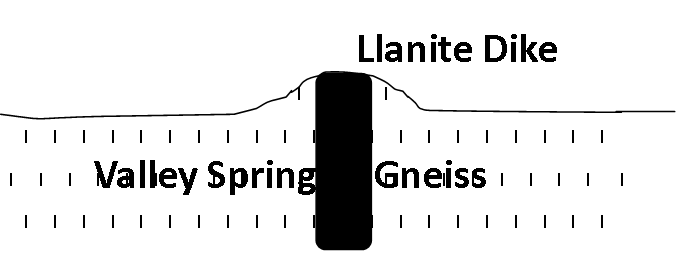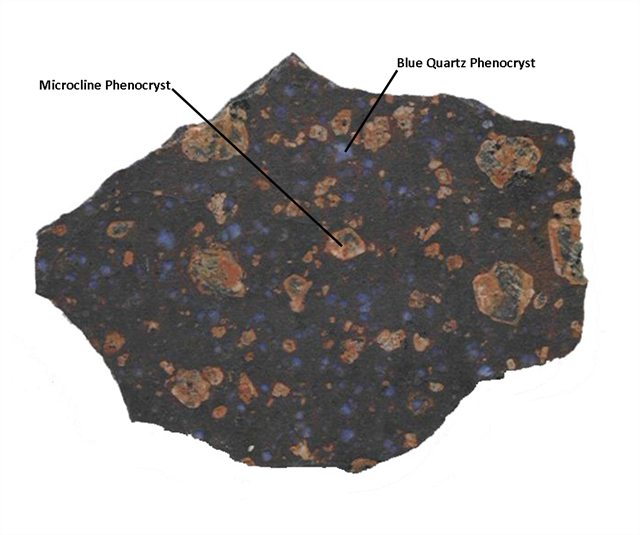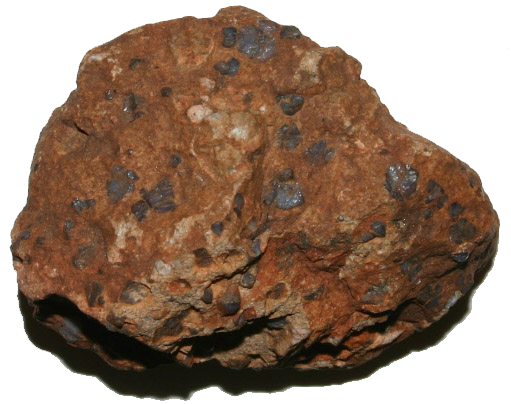Watch for Cacti and loose rocks while at the site. There is a small gravel pullout at the road cut. You can park there to access the llanite dike. The road cut of Texas Highway 16 travels through an east-west ridge of llanite. You will need to examine the llanite and answer some questions (see Logging Requirement) about the site. After you email me the answers, you may log a find.
Llanite
Llano rhyolite, or llanite, is a rhyolite with phenocrysts of microcline and quartz. The quartz found in llanite is blue quartz and is recognized by its euhedral qualities, hexagonal shape, and blue color. The blue quartz phenocrysts' coloring can range from light blue to dark blue. The quartz gets it blue color from ilemnite inclusions in llanite. Microcline is a form of feldspar and microcline phenocrysts can be identified by its reddish, rusty appearance. Notice the phenocrysts are made up of the top two most abundant minerals in the world- feldspar (microcline) and quartz (blue quartz). The phenocrysts are enclosed in a matrix of other minerals (see Mineralogy of Llanite).
Llanite is a very strong rock. Llanite has a crushing strength of 37,800 lb/in2.
Llanite Dike
The llanite deposit at the coordinates was formed when a column of rising magma was solidified in two stages. In the first stage, the magma was slowly cooled deep within the crust, creating small crystals, with a diameter of 2 mm or more. In the final stage, the magma was cooled rapidly and intruded the surrounding gneiss, then crystalized. The llanite dike was the result of this process.

Llanite Dike Cross-section
Story in the Phenocrysts
Phenocysts in llanite can show geologists the time it took the crystals in llanite to form and how deep underground the crystals formed.
Rocks with relatively large phenocrysts were formed deeper underground under many layers of sediment. This is because the crystals had more time to develop as the magma was rising. Phenocrysts that were formed under many layers of sediment are usually easily visible.
Rocks with very small phenocrysts were formed near the surface. As opposed to large phenocrysts, these crystals had little time to form. When this magma cooled, the crystals were significantly smaller. This size of phenocryst is generally very hard to see or sometimes nearly invisible.


(Left) Phenocrysts in Llanite, (Right) Llanite from the llanite dike site
Mineralogy of Llanite
| Mineral |
Percent |
| Quartz |
34.6% |
| Microcline |
27.8% |
| Plagioclase |
27.9% |
| Biotite |
8.6% |
| Fluorite |
1.0% |
| Apatite |
0.13% |
| Magnetite |
trace |
| Ilmenite |
trace |
| Zircon |
trace |
Geologic Terms
Euhedral- a crystal with well-formed and sharp faces
Phenocryst- a conspicuous crystal distinctly larger than a grain of rock
Logging Requirement:
Prior to logging your find, email me the answers to the following logging requirements via geocaching.com. Use the reading and your observations at the site to answer the logging requirements. Title the email "Llanite Rocks! - GC4TWD8 - Logging Requirement". All finds without the required email may be deleted without notice.
- Measure a blue quartz phenocryst in the llanite. What length (in millimeters) is the phenocryst?
- Measure a microcline phenocryst in the llanite. What length (in millimeters) is the phenocryst?
- Based on your conclusions in questions 1 and 2, were llanite phenocrysts formed under many layers of sediment, or near the surface? Did the phenocrysts take a long time to form, or a short time?
- Name three major minerals found in llanite.
- What type of rock is llanite? (sedimentary, metamorphic, or igneous)
Although this is a popular spot to collect llanite, please do not remove the llanite from the dike. This will help preserve the geological feature for others to enjoy. Also, remember to use CITO and Leave No Trace techniques. Happy caching!
FTF goes to DustySandstorm!
I have earned GSA's highest level:
